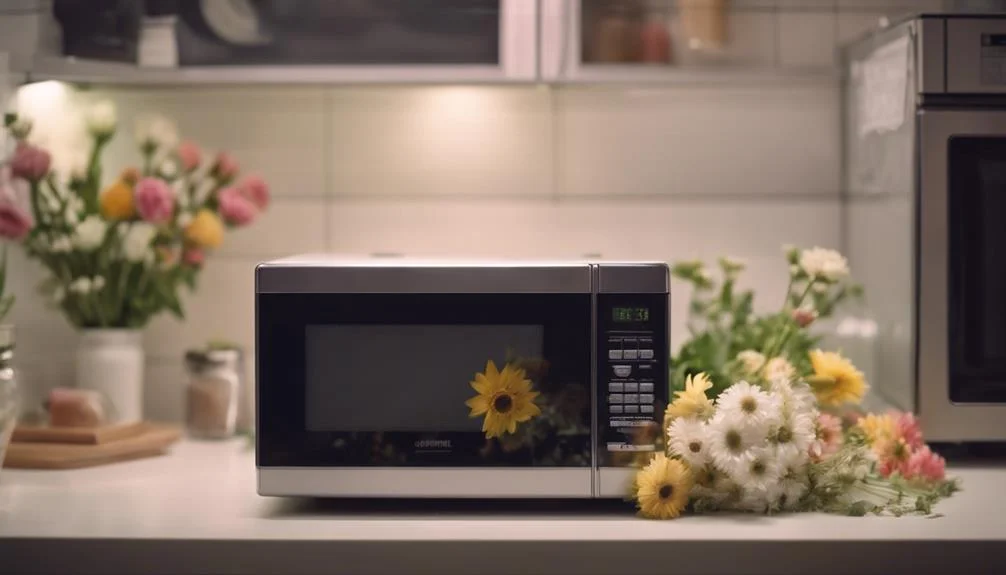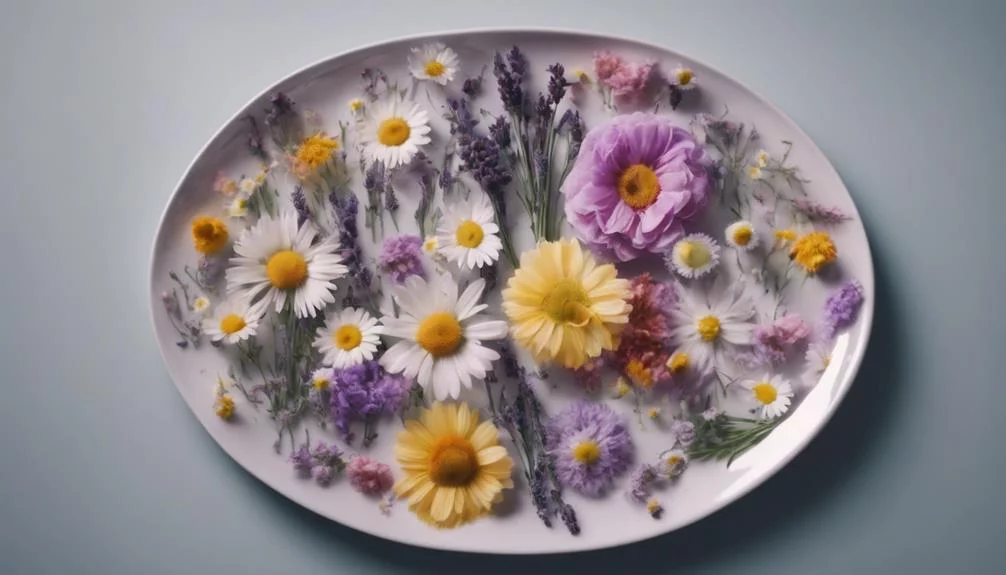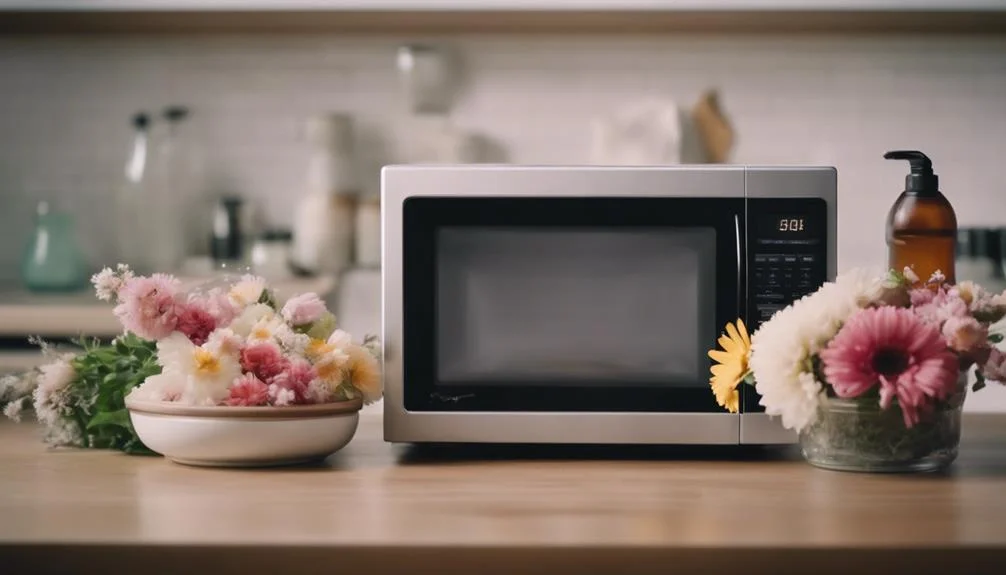Can You Microwave Flowers to Dry Them
Drying flowers in a microwave is a quick and easy method. Start by placing the flowers between two paper towels. Next, set the microwave to a low power setting and heat in short intervals. Check the flowers regularly to prevent them from burning. Once they are dry, allow them to cool before handling them. This method works best for small, delicate flowers. It's important to note that not all flowers can be successfully dried in the microwave, so it's advisable to research which types are suitable.
Key Takeaways
- Microwaving flowers efficiently dries them.
- Color vibrancy is retained in microwaved flowers.
- Use caution to avoid over-drying or burning.
- Best practices ensure successful flower preservation.
Benefits of Microwaving Flowers for Drying
Microwaving flowers for drying presents a convenient and efficient method for preserving botanical specimens. This technique allows for quick and easy preservation while retaining the vibrant colors of the flowers.
In just under five minutes, the microwave can dry the flowers, making it an instant gratification process. The method is particularly beneficial for projects like resin art, where dried flowers maintain their original colors.
Additionally, microwaving flowers for drying requires minimal equipment, adding to its appeal for those looking for a simple and effective preservation method.
Risks Associated With Microwaving Flowers
While microwaving flowers for drying offers numerous benefits, it is essential to be aware of the potential risks associated with this preservation method. One of the primary risks is the possibility of over-drying or burning the flowers, which can result in a loss of color, shape, and overall quality.
Additionally, microwaving flowers may cause them to come out flat, diminishing their natural three-dimensional appearance. Placing flowers directly on paper towels during the microwaving process can lead to uneven drying and potential damage to the delicate petals.
Moreover, the learning curve involved in microwaving flowers varies based on the wattage of the microwave used, making it crucial to monitor the process carefully to avoid these risks and achieve successful flower preservation.
Best Practices for Microwaving Flowers

To achieve optimal results when microwaving flowers for drying, it is recommended to utilize a heavy, flat-bottomed glass bowl or plate for pressing the flowers during the process. When microwaving flowers, it is essential to ensure the container used is microwave safe to prevent any accidents. Additionally, following these best practices will help in effectively drying flowers while preserving their color and shape:
- Use the microwave on half power setting to prevent overheating the flowers.
- Check the flowers after each 30-second interval to monitor their progress.
- Press the flowers gently between the glass bowl or plate to help maintain their form during microwaving.
- Ensure the flowers are completely dry before removing them from the microwave to prevent mold growth.
Step-by-Step Guide to Microwaving Flowers
For optimal results in drying flowers using a microwave, begin by cutting fresh flowers and placing them between paper towels or cotton rags.
Place the flowers in a microwave-safe dish and use another dish as a weight on top. Microwave the flowers at half power for 90 seconds, then check their dryness. If needed, continue microwaving in 30-second increments until the flowers are completely dry.
It is crucial to monitor the flowers closely to prevent over-drying or burning.
This method offers a quick and efficient way to dry flowers for various crafting projects, such as making pressed flowers or creating dried flower arrangements.
Recommended Flower Types for Microwaving

When microwaving flowers for drying purposes, it is essential to consider the type of flower being used. Flatter flowers such as daisies and chamomile are highly recommended due to their suitability for microwaving.
Additionally, yellow flowers are known to retain their color well during the microwaving process, making them another excellent choice for this method of flower preservation.
Best Flowers for Drying
Flatter varieties like daisies and chamomile are highly recommended for microwave drying flowers due to their ability to retain their shape and color effectively. When choosing flowers for microwave drying, consider the following options:
- Daisies and Chamomile: These flatter flowers maintain their shape and color well.
- Statice: Filler flowers like statice can preserve their beauty during the drying process.
- Yellow Flowers: Yellow blooms are known to retain their vibrant color when microwaved for drying.
- Roses: Thicker flowers like roses can be challenging to dry in the microwave but can be halved to improve results.
Selecting the right type of flower is crucial to ensure successful microwave drying while preserving the color and form of the blooms.
Microwave Drying Tips
When looking to efficiently dry flowers using a microwave, it is essential to consider specific flower types that are most suitable for this method. Flatter flowers like daisies and chamomile are ideal for microwaving to dry them quickly and retain color. Yellow flowers, known for their color retention, also fare well with this method. Thicker flowers such as roses can be microwaved after being cut in half to expedite the drying process. However, not all flower types are suitable for microwave drying, so caution must be exercised to prevent over-drying or burning. This quick method offers convenience but requires careful attention to ensure successful results.
| Flower Type | Suitability for Microwaving | Color Retention |
|---|---|---|
| Daisies | Ideal for quick drying | Good |
| Chamomile | Suitable for microwaving | Retained well |
| Yellow Flowers | Recommended for color retention | Excellent |
Flower Preservation Methods
Flower preservation through microwaving as a drying method is particularly effective for certain flower types that can be pressed flat and are not overly delicate. When considering microwaving flowers for preservation, it's essential to select the right flower types. Recommended flower types for microwaving include:
- Daisies and chamomile, which dry quickly when microwaved.
- Yellow flowers, as they tend to retain their color well.
- Roses, although challenging due to their thickness, can be microwaved effectively by cutting them in half.
- Flowers that can be pressed flat, ensuring better results in the microwaving process.
These flower preservation methods can be ideal for creating pressed flower crafts like the Pressed Flower Phone Case.
Tips for Preserving Microwaved Flowers

Preserving microwaved flowers successfully involves utilizing proper techniques to maintain their color and shape for crafting projects. When microwaving flowers, it is essential to press them using a heavy, flat-surface item to ensure they dry evenly.
Checking the flowers every 30 seconds helps prevent over-drying or burning, preserving their vibrant colors. Avoid microwaving flowers directly on paper towels to prevent damage and maintain their integrity.
Once dried, these flowers can be used in various crafts; a low-temp hot glue gun is ideal for adhering them to different surfaces. By following these tips, you can effectively preserve microwaved flowers for use in creative projects while retaining their beauty.
Frequently Asked Questions
Can All Types of Flowers Be Microwaved for Drying, or Are There Specific Varieties That Work Best?
When considering flower selection for microwave drying, prioritize flatter varieties like daisies for optimal results. Adjust microwave duration based on moisture content and petal thickness. Ensure even heat distribution, especially for thicker flowers like roses. Experiment to find the right balance between drying efficiency and fragrance retention. Display arrangements thoughtfully.
How Long Can Microwaved Flowers Be Expected to Last Compared to Traditionally Air-Dried Flowers?
Preservation methods for flowers vary with microwaving and air-drying. Microwaved flowers can last months to a year when sealed properly; however, they may lose color quicker than air-dried flowers, which can last several years when stored away from sunlight and moisture. Display tips are essential for maintaining their appearance.
Are There Any Specific Safety Precautions to Keep in Mind While Microwaving Flowers for Drying?
When utilizing a microwave for flower preservation, prioritize microwave safety and adhere to specific drying methods. Safeguard floral arrangements by ensuring color preservation and scent retention. Implement safety precautions diligently for successful drying and longevity of dried flowers.
Can Microwaving Flowers Alter Their Color or Scent in Any Way?
Microwaving flowers can alter their color and scent due to heat exposure and moisture removal during the drying process. Vibrant flowers may retain their color, but delicate or highly aromatic varieties could lose their scent.
Are There Any Special Techniques for Arranging Microwaved Flowers in a Vase for Display?
When arranging microwaved flowers in a vase, consider vase placement for optimal display, maintain proper water level to keep blooms fresh, trim stems at an angle for water absorption, and explore creative arrangement tips and display ideas for a stunning floral presentation.
Conclusion
In conclusion, microwaving flowers for drying can be a convenient and efficient method for preserving their color and shape.
However, caution must be taken to avoid over-drying or burning the flowers.
By following best practices and selecting suitable flower types, you can successfully create dried flowers for various craft projects.
Remember, just like flowers, patience and attention to detail are essential for achieving beautiful results.






